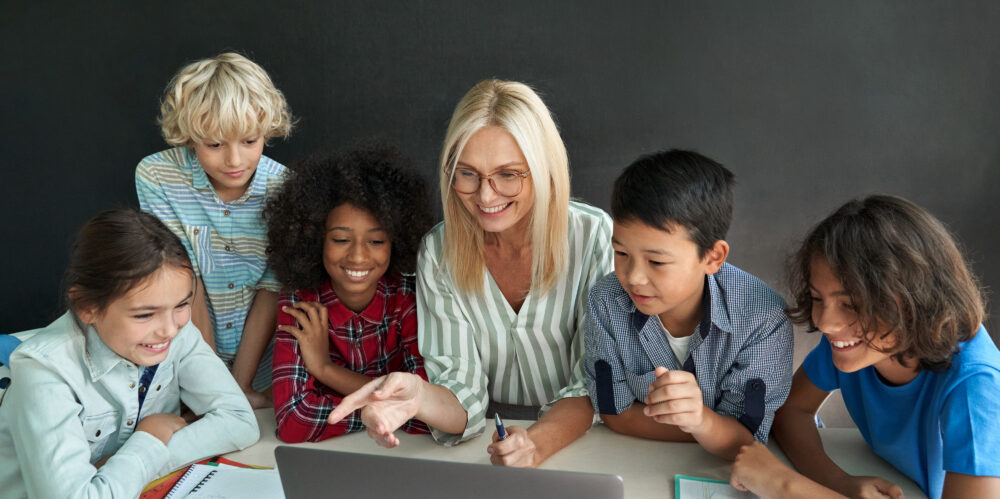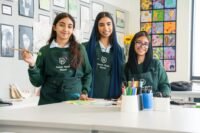While the GCC schools were in for a rough ride, there have been many noteworthy changes
Dubai, July 06, 2022: The education industry has witnessed transformational changes since the beginning of the academic year 2021-22. Be it constant adjustments to teaching methodologies where schools were switching between remote, in-person and hybrid learning, or gradually moving back to a more permanent in-person teaching approach, it has been a year of many firsts.
The second wave of COVID-19 affected everyone. Schools, teachers and students had to come up with innovative strategies to keep up the momentum and ensure that both teaching and learning continued with the existing realities. What resulted was several noteworthy changes that had a significant impact on the future of the education system.
As the academic year 2021-2022 comes to an end, let’s have a look at some of the key changes in education across the GCC.
Classroom technology
Recourse to technology was but a natural choice in these times of crisis. While it was rather easy to replace physical classes with virtual classes, more challenging was to assess the impact on students.
Schools upgraded the digital infrastructure by providing Office 365 accounts for all students with online access to MS office tools and other apps; OneNote Class Notebook was used as e-portfolio in place of physical folders; BYOD strategies were put in place; and provision of smart screens in classrooms and teacher continuous professional development (CPD) sessions in the new context facilitated effective technology integration in teaching and learning.

Explaining about technologies that have reshaped the classroom experience for students in the year 2021-22, Punit M.K. Vasu, CEO, The Indian High Group of Schools says, “Storing and sharing of digital content through OneDrive, using MS Forms as assessment tool and attending live events to watch events, counseling programmes and talks enhanced their learning experience.”
Schools provided digital reading resources that helped students experience new ways of learning while teachers became more confident in incorporating technology in their lessons with the use of multiple web tools such as simulations in science and virtual tours/google maps in SST and Desmos in Maths to deliver their daily lessons. All these factors contributed to enhanced student engagement and learning, adds Vasu.

Schools also introduced the use of Microsoft teams with live cameras in the classrooms to ensure all students regardless of whether they were online or in the classroom were fully able to access the curriculum. Sean Lewis, Senior Leadership Team, Designated Safeguarding Lead- Child Protection, Star International School, Al Twar says, “We used technologies to aid the learning experience to encourage collaboration by enabling students to share and discuss using the chat function, having their cameras on and communicating directly.”
According to Vasu, teachers became more confident in leveraging technology for their lessons and used multiple web tools to deliver them.

However, while many schools were adapting to innovative technologies, they were also trying to strike the right balance. Jason King, Principal, Regent International School says, “Our schools have been adapting to innovative technologies prior to COVID. For us it has been more about the people and communication alongside technologies. We have worked with our students and families, and we have come out even more resilient as a community than before, together with enhanced use of technology but getting the balance right to ensure there is not an over reliance on technology and its use.”
Facilities management
Schools had to adopt new measures in terms of school infrastructure and safety precautions, while complying with strict regulatory guidelines.
Some of the fundamental practices of schools had to be modified to adjust to new realities. Schools were forced to create an environment that fosters safety, comfort and productivity. Measures ranged from conducting temperature checks and symptom screening to creating increased desk spacing, maintaining a stipulated distance in the common spaces, creating proper ventilation and ensuring the policies for masks were followed.

Mark Lentz, Head of School/CEO of GEMS American Academy Qatar and GEMS Education Country Director says, “Facilities management has changed dramatically. Simple requirements such as taking each student’s temperature required our school to completely revamp our entrance area as well as our morning drop off procedures. We haven’t had use of our parent café or student canteens in over two years. Many of our playgrounds were segregated into smaller areas so that students could still play outside without cross contaminating their ‘bubbles’.”
Meanwhile, schools also had to put a number of restrictions to meet with the government guidelines to maintain the safety of all of its stakeholders. “This included hygiene equipment being readily available and increased sanitisation and cleaning throughout the school day,” says Lewis.
According to Daryl Sims, Head of Learning, The English College Dubai, schools directed the students’ movement in the halls, adding visual reminders of the rules and changing the layout of the classrooms from a dynamic table setup to a more traditional forward-facing format with perspex screens in between students.
Sports
In the past year, schools took conscious steps to bring sports education back on track after a series of disruptions during the lockdown and the initial phase of hybrid learning. While following mandated regulatory guidelines set by relevant authorities, schools had to facilitate a gradual move back with a series of new initiatives.

Robert Rinaldo, Head of School at GEMS American Academy – Abu Dhabi says, “We started with clinics and activities, first outdoors and then in the gym, practicing and playing against our own teammates, strictly following the latest protocols. Eventually we were able to compete against other schools. The only people allowed to participate in practice sessions or games were the athletes and their coaches.”
It was important for schools to put in place appropriate sanitisation and disinfection mechanisms in sporting areas and for commonly used equipment and establish hygiene checkpoints to ensure students and staff were safe to participate, says Lewis.
Activities like swimming were completely stopped for several months of the academic year. In fact, schools started a few activities online just to keep the students active.

Finally as the COVID situation eased, schools started introducing competitive sports back during PE lessons and in squads. Naveed Iqbal, Principal/ CEO of GEMS Metropole School – Motor City, Dubai says, “It was very clear from the student body that they wanted to get back into sports. This was also seen during the high uptake of the sports-based after-school clubs which were always full.”
Meanwhile, Qatar is yet to officially return to sports. As Lentz points out, “In Qatar we have not returned to sports yet. However, we are hopeful we will be able to bring back our competitive sports programmes next school year.”
Teaching
For teachers, the past two years have been one of the most challenging times. Educators had to adapt to remote teaching and adjust to unexpected conditions using synchronous and asynchronous modes of instruction. Teachers and school management had to establish connections with students, families and colleagues at a time when social bonds were almost non-existent.
To upskill teachers to deal with all the changes, schools encouraged them to participate in online training and webinars to learn and adapt to the international best practices. Vasu says, “Technology experts and digital learning coaches from schools shared the best practices for remote learning and acknowledged and appreciated good lessons by teachers, motivating them to give their best on this uncharted terrain.”
According to Iqbal, as a result of the experiences gained during the pandemic, teachers are now able to adapt to any circumstance. Today, teachers are highly IT literate, compared to pre-pandemic days when fewer teachers were strong in technology compared to others.
Meanwhile, schools have started paying increased attention to the well-being of their teachers. According to Lewis, initiatives that have helped teachers include regular, scheduled activities to support their well-being and a supportive work environment allowing them to balance their work lives with their personal needs.
Hybrid learning and filling the gaps
The year 2021-22 was dominated by hybrid learning and academicians are divided on what impact it has had on student learning. While some are of the opinion that students made strong progress during this time, others feel that it has created gaps in learning and also affected social development across all ages.
According to Vasu, during the past year as a result of hybrid learning some students thrived “because the format was a closer match to their personality and/or learning preferences.” Some others, he says, have fallen back in social- emotional development because they were confined to homes.
The learning gaps, according to him, were most prominently in some strands/ topics in science in which practical lessons in the lab complete the learning. “While virtual experiments/ simulations were explored as close substitutes, they did not have the same impact,” he says, adding that schools in an effort to address the gaps in learning conducted suitable practical lessons as a carry forward learning and/or addressed through creative discussions in classrooms and through demonstration. “Data conversations have enabled teachers to identify students with learning gaps and use assertive mentoring to bridge them effectively. It has helped in adjusting the balance of synchronous and asynchronous lessons.”
Meanwhile King observed that Hybrid learning has brought out the introverts, the students who would normally hesitate to volunteer or step forward. “They find it more comfortable to share ideas while doing it in a virtual setting,” he says, adding that older children have had to deal with exam pressures, while going through a host of emotions with their families and what has been going on in the world.
Sims says students made strong progress thanks to the amount of hard work that went into offering live lessons during the height of the pandemic. “However, the gaps are perceived as more social and learning skills-based,” he adds.
Iqbal also underscores the impact the past year has had on students’ overall development. “Far more noticeable than these academic gaps were the gaps in socio-emotional development across all ages.
STEAM and robotics
The pandemic severely hampered the hands-on approach of STEAM lessons. As most schools moved to distance learning starting March 2019, STEAM lessons continued through virtual simulation, DIY and digital activities. In 2021-22, students had an opportunity to work on physical experiments in science classes and labs. According to Vasu, after school technology programmes helped students gain STEM robotics and coding skills. Under the Bring Your Own Robot (BYOR) programme, the students worked with mBots to learn electronics, mechanics and coding, the three components of robotics.
King says students have now started to approach STEAM-related problems more empathetically, i.e., keeping in mind the human aspect of their projects, which is a refreshing and much needed approach.
However, Sally Vale, Academic Director, ITC International School feels that ever since COVID-19 restrictions, these activities have suffered and children are still catching up.
Student well-being
Post pandemic, educators were confronted with student wellbeing and in an effort to deal with the issue, schools developed new strategies. Explaining various support methods for students’ wellbeing, King says that positive education is embedded and integrated into every part of the teaching methodology. “We have a ‘Values in Action’ system where students are encouraged to highlight how their actions are in line with some of the values and character strengths.”
Meanwhile, schools have enhanced pastoral care, appointed counsellors and have increased inclusion team support to help provide specialist support to students. Lewis says the school also appointed a school counsellor who is a trained and qualified children’s psychologist to support specific individual needs of the children.
These strategies have resulted in making students more resilient. According to King, “The greatest outcome has been this new generation of exceptionally resilient students who have learnt to adapt, innovate and evolve through the pandemic and come out stronger.”








